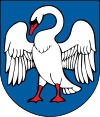 Alternate names: Jonava [Lith], Yanove [Yid], Ianovo [Rus], Janów [Pol], Janova, Janovo, Janowa, Janowo, Yanova, Yonava, Ionava, Janów nad Wilią, Jonavos Miestelis, Russian: Яново. יאַנעווע-Yiddish. 55°05' N, 24°17' E, 20 miles NE of Kaunas (Kovno) non Nevis River (the Vilye). Yizkors: Sefer Yanovah: le-hantsahat zikhram shel Yehude ha-ayarah she-neherevah ba-Sho'ah (Tel Aviv, 1972) and Lite (vol. 1) (New York, 1951). ShtetLink.
Alternate names: Jonava [Lith], Yanove [Yid], Ianovo [Rus], Janów [Pol], Janova, Janovo, Janowa, Janowo, Yanova, Yonava, Ionava, Janów nad Wilią, Jonavos Miestelis, Russian: Яново. יאַנעווע-Yiddish. 55°05' N, 24°17' E, 20 miles NE of Kaunas (Kovno) non Nevis River (the Vilye). Yizkors: Sefer Yanovah: le-hantsahat zikhram shel Yehude ha-ayarah she-neherevah ba-Sho'ah (Tel Aviv, 1972) and Lite (vol. 1) (New York, 1951). ShtetLink.
Jewish history of Jonava. 1900 Jewish population: 3,975, one of the largest Jewish communities in Kaunas guberniya. Jews settled in Jonava around the founding of the town in 1775 from the nearby village of Skarulu, home to more than 300 Jews. Most were blacksmiths, fishermen, small merchants and raftsmen. The Petersburg-Berlin highway [now the Kovno-Ezheren] built in 1852 passed through Yaneva from Dvinsk to Kovno-Warsaw and Berlin. In 1873, the Libau-Romania railroad line was completed, further developing the town's grain and lumber trade grew. In 1877, almost the entire town flooded; and in 1895 and 1904 it suffered two devestating fires. In 1915, all Jews of Yaneva were effected an edict ordering them to leave the town to which they returned in 1917-1921 to find that almost everything destroyed by the German occupation. Forces had converted many of the homes into stables for their horses. During the inter-war period, Jews were the majority of the town population: 2,710 Jews (65%) in 1932 reaching 3,000 on the eve of WWII out of 5,000 total, but the previously cordial relationship with Christians declined.. The majority of the Jews in the town were engaged in industry, crafts and trade and had 7 synagogues, religious and secular schools, libraries, political, cultural and sports organisations. In 1929, the Jonava Jewish Volksbank had 560 depositors. When the war broke out, many of the Jews in Kaunas and Jonava tried to escape as German aircraft and Lithuanian anti-Soviet partisans shelled and bombed. Some fugitives were killed or injured. Others hid in neighboring villages or returned home. Some escaped to Russia. [March 2009]
CEMETERY: Photo. JOWBR burial listing. [March 2009]
information. [September 2010]
MASS GRAVES: On June 24, 1941, Lithuanian partisans blocked the roads from Jonava, forcing escaping Jews to return to Jonava and fired at a Soviet military train heading East from Kaunas. German troops occupied Jonava on June 25 when a fierce battle burned many buildings. Jews from Jonava trying to hide in Kaunas were arrested and shot. At the beginning of July, a "partisa"n squad of 50-60 ]white-bands' organised in Jonava as a "self-defense battalion" subordinate to the local Wermacht and Gestapo to persecute and exterminate communists and Jews. On August 7, the governor of Kaunas County issued orders for settling Jews in ghettos by August 15. The squads drove all the Jewish men into the barracks near the Neris River where the Jewish ghetto had been established. The Jews dug several large pits in Girelka (Giraite) forest outside Jonava (about 1.5 km NE). On August 14, the Jews were lined up and taken to Giraite forest -- told they were being driven to work. With several Gestapo officers and a squad of soldiers present, a group of Jewish men realised what was happening and started running from the forest. Although the majority were shot, six men escaped. Later, five were arrested and shot. Only Nachumas Bliumbergas survived. 552 Jews (497 men and 55 women) were forced into the pits and shot by German and Lithuanian soldiers. A few communists were among those shot. After the first mass killing, the surviving Jewish families spent a couple of weeks in their homes until being forced into the ghetto, leaving most of their belongings behind. Locals loitered in wait as 12 soldiers of the battalion guarded. The Jews spent a couple of days in the barracks until paying a 120,000 rubles "ransom" on August 23-24. 1,257 Jews lived in Jonava Rural District before the second mass execution took place between 31 August and 2 September. 16 white-bands did the murders and were given vodka. The Jews were driven to Giraite forest in groups. The shooting was done not only by the members of Jonava squad but also by "partisans" from other areas and several Germans, all dressed as civilians. Before the shooting ,the victims had to strip to underwear. As soon as one group was executed, the bodies were buried under sand and chalk, then another group was brought to the pit and shot. Even some of murders could not stand the horrible sight. The men were shot first and then women and children--1556 Jews (112 men, 1200 women, and 244 children). Only 200 women and children remained in Jonava Ghetto. Jonava's population was very dissatisfied with the shootings. To quiet public opinion, the remaining Jonava Jews were taken to Kaunas ghetto on October 4, 1941. Near the end of Nazi occupation (Summer 1944), the Germans tried to eliminate evidence of their crime in Giraite forest. For almost two weeks, Jewish remains were burned at the massacre site surrounded by soldiers to prevent non-authorised persons, who were strictly forbidden to approach. [March 2009]
